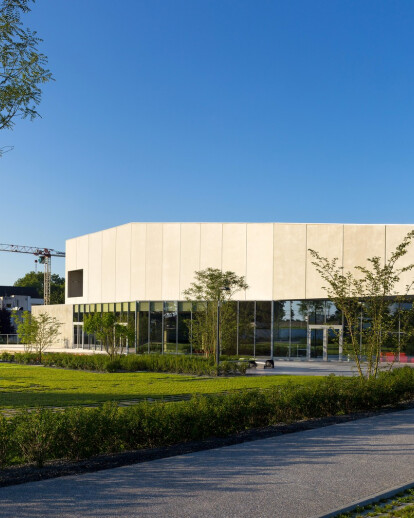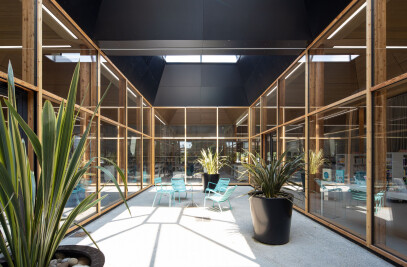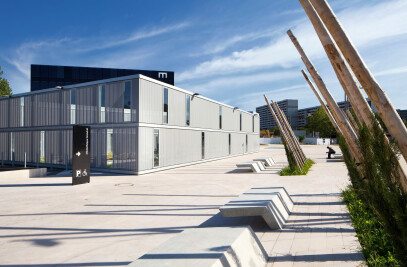The town of Chasseneuil-du-Poitou wished to build a new hall for festivities and cultural events in a redevelopment area centred around the railway station. Designs for the new Hall had to respect the Technological Risks Prevention Plan implemented in the area. The building designed by King Kong was therefore positioned at a tangent to the outer perimeter demarcating this zone, oriented so as to limit noise pollution for those living in housing to the south of the plot. The Hall serves as a shield for the residential neighbourhoods beyond it, while to the north it provides open access to a landscaped area designed in close connection with the specific function of the building itself. The building forms a deliberately compact volume which, on its south-facing façade, provides easy access for deliveries to the catering facilities and bar and ample parking spaces, kept separate here from the more ‘dignified’ entrance designed for greeting spectators and guests. The back-stage access area is strategically positioned on the building’s eastern façade, out of sight from visitors.
The public gains entrance to the building on its north-western façade, by means of a covered courtyard area which functions as a convivial plaza, reserved for pedestrian use alone and equipped with welcoming benches for talking or resting. The ample glazing of the atrium intuitively guides spectators towards the main entrance. Concrete was chosen for the construction of the load-bearing structure of the whole, due to its thermal and acoustic qualities and cost-effectiveness. The entrance hall, situated at the building’s prow, is generously proportioned and careful attention has been paid in its layout to the variety of functions accommodated, making it easy for the public to get their bearings. A loggia with ample planting is situated at the building’s centre, lit from above by natural light. It serves as a means of allowing light and the natural environment to permeate the building, creating an almost dreamlike feel at the building’s heart. Movement inside the entrance hall is designed to be free and easy, and glimpses maybe caught, as one moves through it, of the outside spaces, creating an overall sense of comfort, space and conviviality.
Easy-to-regulate access is provided to the main hall. The latter serves two main functions – festivities and cultural events – each with their own specific design requisites and, in some respects, conflicting needs. This led the architects to imagine a double-oriented entity. Indeed, the hall is used along its a east-west axis, looking towards the stage, when used for shows or the performing arts, but is used along its north-south axis when used as a banqueting hall. In the latter case, the hall opens onto the outside spaces and landscaped gardens beyond. The installation of a high performance acoustic partition makes it very easy to switch the hall’s layout, and it is possible to plunge the auditorium into total darkness if required. The slightly asymmetric volume of the extremely spacious hall creates a sense of heightened amplitude, and it is also possible to use its full scale for shows not requiring the installation of tiered seating. Meticulous attention was paid to the hall’s acoustics, and this had a great impact on aesthetic choices. Lighting was also treated with the utmost care and the ceiling lights chosen suit the hall’s use both as a space for the performing arts and banqueting. The wall at the rear of the stage has been designed as a ‘living panel’ and offers a diverse range of openings, providing easy access to the storerooms beyond.
When the banqueting hall is opened onto the exterior spaces, it offers a terraced space which plays on the natural incline of the land, rising above the entrance courtyard like a superb podium for celebrating official or formal events (such as weddings, for instance) held within the building. The architects paid keen attention to the design of the back stage spaces, with specific access points for artists and stage crew, a loading deck protected from inclement weather and very well-equipped wings. A staircase leads artists up to the first-floor dressing rooms which enjoy private terraces. The ample foyer leads to a loggia with views of the hall below. Technicians use the same staircase to reach the gangway leading to the lighting desk and sound controls room. Access to these varying spaces is regulated through double doors. Outside, the building’s overall volume plays elegantly on gentle dips and inclines. The stamped concrete and green roof ensure that this new amenity blends effortlessly with the surrounding urban context of the town.
The building’s urban integration is heightened by the controlled layout of parking spaces based on the principle of dedicated bands. The aim was to retain the guiding principle and feel of a landscaped park, obtained through the use of plants as screening. Different aesthetic choices were made, including concrete and stabilised sand at the west and northern limits of the plot, while grass concrete pavers have been used for the parking areas and driveways (a different type of paving slab has been implemented for each distinct function). The pathways use stabilised sand. Trees have been planted to enhance the whole, in such a way as to avoid monotonous lines. The tall branches of the species chosen will, as the years go by, serve to screen views of the cemetery. The architects have made every effort here to provide the town of Chasseneuil-du-Poitou with an effective new cultural amenity which caters to the specific desiderata defined for the project, the technical requirements inherent to it and the urban framework within which it is situated. The material and immaterial nature of the surrounding environment have been given pride of place so that the new building may enter into meaningful resonance with its context, echoing back the energy and responsiveness of the town as a whole.

































